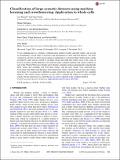Files in this item
Classification of large acoustic datasets using machine learning and crowdsourcing : application to whale calls
Item metadata
| dc.contributor.author | Shamir, L. | |
| dc.contributor.author | Yerby, C. | |
| dc.contributor.author | Simpson, R. | |
| dc.contributor.author | Von Benda-Beckmann, A.M. | |
| dc.contributor.author | Tyack, P. | |
| dc.contributor.author | Samarra, F. | |
| dc.contributor.author | Miller, P. | |
| dc.contributor.author | Wallin, J. | |
| dc.date.accessioned | 2014-09-05T10:31:01Z | |
| dc.date.available | 2014-09-05T10:31:01Z | |
| dc.date.issued | 2014-01-01 | |
| dc.identifier | 145950020 | |
| dc.identifier | 794df8db-9371-4452-9e8a-8b386eb85e55 | |
| dc.identifier | 84900602686 | |
| dc.identifier | 000331846000048 | |
| dc.identifier.citation | Shamir , L , Yerby , C , Simpson , R , Von Benda-Beckmann , A M , Tyack , P , Samarra , F , Miller , P & Wallin , J 2014 , ' Classification of large acoustic datasets using machine learning and crowdsourcing : application to whale calls ' , Journal of the Acoustical Society of America , vol. 135 , no. 2 , pp. 953-962 . https://doi.org/10.1121/1.4861348 | en |
| dc.identifier.issn | 0001-4966 | |
| dc.identifier.other | ORCID: /0000-0002-8409-4790/work/60887894 | |
| dc.identifier.uri | https://hdl.handle.net/10023/5353 | |
| dc.description | A.M.v.B.B. acknowledges support from the Sea Mammal Research Unit at the University of St. Andrews (Professor Ian Boyd) and Woods Hole Oceanographic Institution for the Whale FM project. P.T. received funding from the Marine Alliance for Science and Technology for Scotland (MASTS). | en |
| dc.description.abstract | Vocal communication is a primary communication method of killer and pilot whales, and is used for transmitting a broad range of messages and information for short and long distance. The large variation in call types of these species makes it challenging to categorize them. In this study, sounds recorded by audio sensors carried by ten killer whales and eight pilot whales close to the coasts of Norway, Iceland, and the Bahamas were analyzed using computer methods and citizen scientists as part of the Whale FM project. Results show that the computer analysis automatically separated the killer whales into Icelandic and Norwegian whales, and the pilot whales were separated into Norwegian long-finned and Bahamas short-finned pilot whales, showing that at least some whales from these two locations have different acoustic repertoires that can be sensed by the computer analysis. The citizen science analysis was also able to separate the whales to locations by their sounds, but the separation was somewhat less accurate compared to the computer method. | |
| dc.format.extent | 10 | |
| dc.format.extent | 1391540 | |
| dc.language.iso | eng | |
| dc.relation.ispartof | Journal of the Acoustical Society of America | en |
| dc.subject | QH301 Biology | en |
| dc.subject.lcc | QH301 | en |
| dc.title | Classification of large acoustic datasets using machine learning and crowdsourcing : application to whale calls | en |
| dc.type | Journal article | en |
| dc.contributor.institution | University of St Andrews. School of Biology | en |
| dc.contributor.institution | University of St Andrews. Marine Alliance for Science & Technology Scotland | en |
| dc.contributor.institution | University of St Andrews. Sea Mammal Research Unit | en |
| dc.contributor.institution | University of St Andrews. Sound Tags Group | en |
| dc.contributor.institution | University of St Andrews. Bioacoustics group | en |
| dc.contributor.institution | University of St Andrews. Scottish Oceans Institute | en |
| dc.contributor.institution | University of St Andrews. Institute of Behavioural and Neural Sciences | en |
| dc.contributor.institution | University of St Andrews. Centre for Social Learning & Cognitive Evolution | en |
| dc.identifier.doi | https://doi.org/10.1121/1.4861348 | |
| dc.description.status | Peer reviewed | en |
This item appears in the following Collection(s)
Items in the St Andrews Research Repository are protected by copyright, with all rights reserved, unless otherwise indicated.

